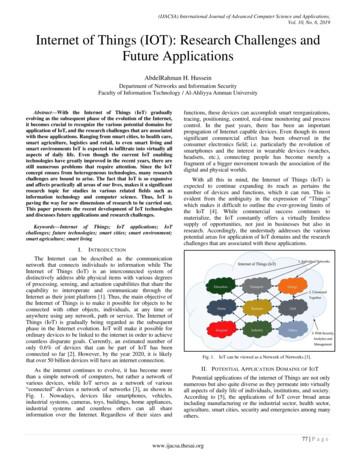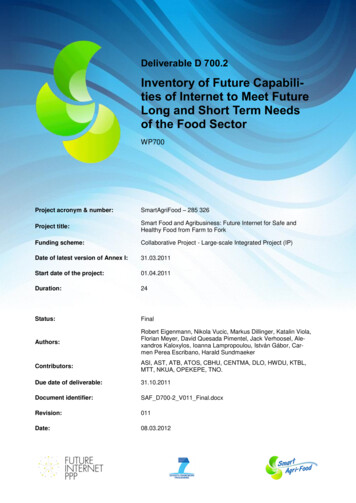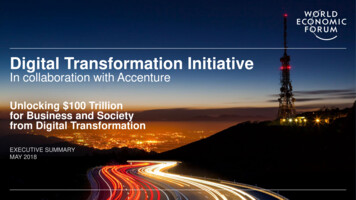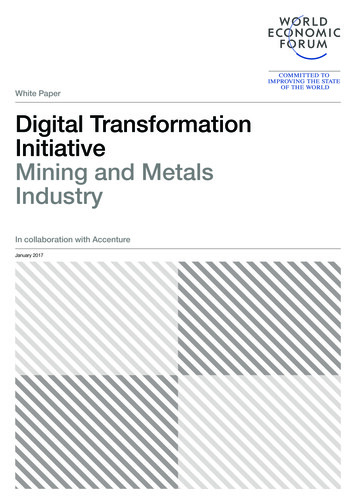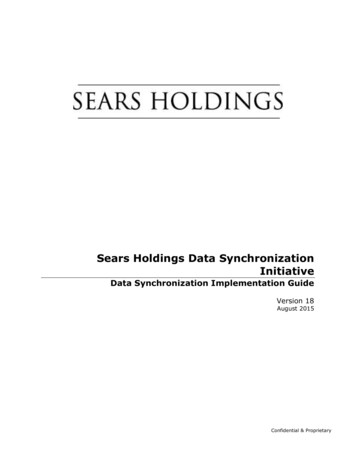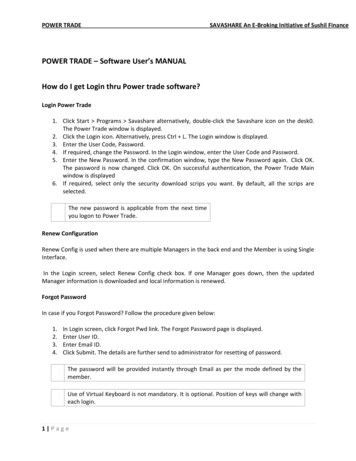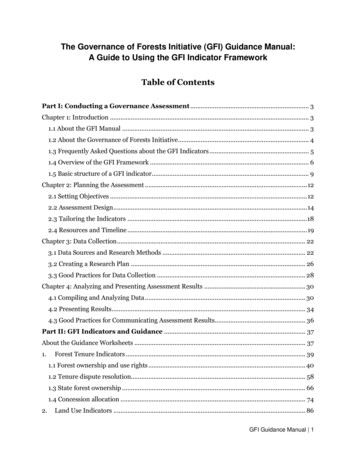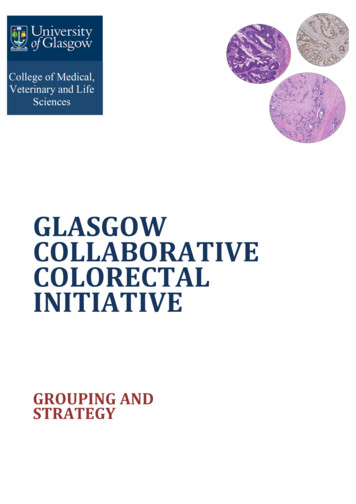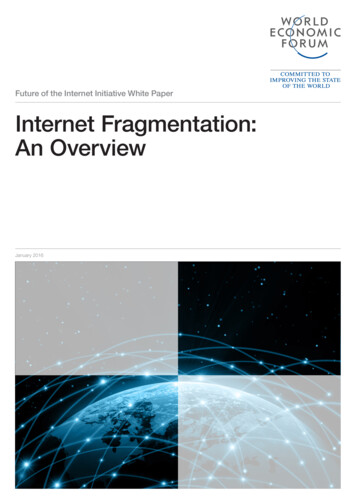
Transcription
Future of the Internet Initiative White PaperInternet Fragmentation:An OverviewJanuary 2016
Future of the Internet Initiative White PaperInternet Fragmentation: An OverviewWilliam J. DrakeVinton G. CerfWolfgang KleinwächterJanuary 2016
ContentsPrefaceExecutive SummaryIntroduction1. The Nature of Internet FragmentationThe Open InternetWorking DefinitionsThe Variability of Fragmentation2. Technical FragmentationAddressingInterconnecting the Network of NetworksThe Domain Name SystemSecurity3. Governmental FragmentationNational Sovereignty and CyberspaceContent and CensorshipE-Commerce and TradeNational SecurityPrivacy and Data ProtectionData LocalizationCybersovereignty4. Commercial FragmentationPeering and StandardizationNetwork NeutralityWalled GardensGeo-Localization and Geo-BlockingIntellectual Property5. ConclusionsAbout the 29313133353739414549495052555658646667The views expressed in this White Paper are those of the author(s) and do not necessarily represent theviews of the World Economic Forum or its Members and Partners. White Papers are submitted to the WorldEconomic Forum as contributions to its insight areas and interactions, and the Forum makes the finaldecision on the publication of the White Paper. White Papers describe research in progress by the author(s)and are published to elicit comments and further debate.
1PrefaceThe World Economic Forum Annual Meeting 2015 in Davos-Klosters includeda session entitled, Keeping "Worldwide" in the Web. Participants discussed anumber of challenges facing the open global Internet, which has become akey driver of global wealth creation, socio-cultural enrichment and humanempowerment in recent decades. Among the top concerns raised was theemerging fragmentation of the Internet along multiple lines due todevelopments in the technical, governmental and commercial realms. In themonths to follow, it became clear that while this fragmentation was of growingconcern to many close observers of and participants in the global Internetecosystem, there was no widespread consensus as to its nature and scope.As such, with the launch of the World Economic Forum’s multi-year Future ofthe Internet Initiative (FII), Internet fragmentation stood out as one of thepriority topics meriting exploration in the context of the FII’s Governance onthe Internet project.To facilitate the discussion, the Forum invited William J. Drake, who had beena discussion leader at the Annual Meeting session, to organize a small teamof experts that could produce a background paper on the subject. This teamincluded Vinton Cerf, widely regarded as a “father of the Internet”, andWolfgang Kleinwächter, a leading figure in global Internet governanceinstitutions. The team’s mandate was to contribute to the emergence of acommon baseline understanding of Internet fragmentation by undertaking ahorizontal mapping of the issues and dynamics involved. That is, its intendedvalue-added would be in presenting a big picture overview of a range ofexamples illustrating the trend towards fragmentation, rather than in offeringfinely detailed portraits of any of them.From the outset of the process, the World Economic Forum engaged anumber of interested participants in the FII’s Core Community, as well as agroup of external experts. The research in progress was discussed both atmeetings held in Geneva and New York and on conference calls to engage indialogue and gather feedback, and over a dozen written replies to the draftversion were received as well. All these inputs were taken into considerationby the team of authors. Ultimately though, the views expressed in the paperare solely those of the authors working in their individual capacities, and notnecessarily those of their respective organizations, or of the World EconomicForum itself or its Members or Partners.I would like to thank the authors for their intellectual leadership in developingthis analysis, which is an important, new resource for everyone concernedabout the evolution of the Internet. I would also like to express appreciation tothe informal multistakeholder group of experts who reviewed earlier drafts andprovided comments to the authors. The Forum particularly wishes torecognize the leadership and support of the trustees and partners of theGlobal Challenge Initiative on the Future of the Internet, of which this
2workstream is a part, as well as the Initiative's Co-Heads, Mark Spelman andAlex Wong, and its Director, Danil Kerimi.As a first-cut overview of the fragmentation landscape, this paper will help toset a foundation for further analyses and action-oriented dialogues among FIIparticipants and within the international community at large. It wascommissioned for the explicit purpose of providing a more informed basis forthe identification and prioritization by all stakeholders of potential areas ofcollaboration, including the definition of good practices or policy models thatcan serve as a constructive example for others. A first step down this path willbe taken with the Annual Meeting 2016 session on Internet without Borders.As the title of this session suggests, the Forum’s engagement in this issuearea is guided by a conviction that keeping the Internet as open andinteroperable as possible is essential if we are to sustain and expand itscapacities to promote global well-being in the years ahead.Richard SamansMember of the Managing BoardGeneva, January 2016
3Executive SummaryA growing number of thought leaders have expressed concerns over the pasttwo years that the Internet is in some danger of splintering or breaking up intoloosely coupled islands of connectivity. A number of potentially troublingtrends driven by technological developments, government policies andcommercial practices have been rippling across the Internet’s layers, from theunderlying infrastructures up to the applications, content and transactions itconveys. But there does not appear to be a clearly defined, widely sharedunderstanding of what the term, fragmentation, does and does not entail.The growth of these concerns does not indicate a pending cataclysm. TheInternet remains stable and generally open and secure in its foundations, andit is morphing and incorporating new capabilities that open up extraordinarynew horizons, from the Internet of Things and services to the spread of blockchain technology and beyond. Moreover, the increasing synergies betweenthe Internet and revolutionary changes in other technological and socialarenas are leading us into a new era of global development that can be seenas constituting a fourth industrial revolution. But there are challengesaccumulating which, if left unattended, could chip away to varying degrees atthe Internet’s enormous capacity to facilitate human progress. We need totake stock of these, and to begin a more structured dialogue about theirnature, scope and distributed collective management.The purpose of this document is to contribute to the emergence of a commonbaseline understanding of Internet fragmentation. It maps the landscape ofsome of the key trends and practices that have been variously described asconstituting Internet fragmentation and highlights 28 examples. A distinction ismade between cases of technical, governmental and commercialfragmentation. The technical cases generally can be said to involvefragmentation “of” the Internet, or its underlying physical and logicalinfrastructures. The governmental and commercial cases often more directlyinvolve fragmentation “on” the Internet, or the transactions and cyberspace itconveys, although they also can involve the infrastructure as well. With theexamples cited placed in these three conjoined baskets, we can get a holisticoverview of their nature and scope and more readily engage in the sort ofdialogue and cooperation that is needed.Section 1: The Nature of Internet FragmentationThe open Internet provides a baseline approach from which fragmentationdeparts and against which it can be assessed. Particularly important are thenotions of global reach with integrity; a unified, global and properly governedroot and naming/numbering system; interoperability; universal accessibility;the reusability of capabilities; and permissionless innovation.
4The conventional four-layer technical model of the Internet can analyticallysupplemented by the addition of a fifth content and transactions layer.Working definitions are proposed for three forms of fragmentation:Technical Fragmentation: conditions in the underlying infrastructure thatimpede the ability of systems to fully interoperate and exchange data packetsand of the Internet to function consistently at all end points.Governmental Fragmentation: Government policies and actions that constrainor prevent certain uses of the Internet to create, distribute, or accessinformation resources.Commercial Fragmentation: Business practices that constrain or preventcertain uses of the Internet to create, distribute, or access informationresources.In each case, fragmentation may vary greatly according to a number ofdimensions or attributes. The paper highlights four in particular: Occurrence: whether a type of fragmentation exists or is a potentialIntentionality: whether fragmentation is the result of deliberate action or anunintended consequenceImpact: whether fragmentation is deep, structural and configurative oflarge swaths of activity or even the Internet as a whole, or rather moreshallow, malleable and applicable to a narrowly bounded set of processes,transactions and actorsCharacter: whether fragmentation is generally positive, negative, or neutralSection 2: Technical FragmentationWhen the Internet concept was first articulated, a guiding vision was thatevery device on the Internet should be able to exchange packets with anyother device. Universal connectivity was assumed to be a primary benefit. Butthere are a variety of ways in which the original concept has been erodedthrough a complex evolutionary process that has unfolded slowly but isgathering pockets of steam in the contemporary era.Four issue-areas are reviewed, including Internet addressing, interconnection,naming and security. Within these categories, 12 kinds of fragmentation ofvarying degrees of significance are identified:1.2.3.4.5.Network Address TranslationIPv4 and IPv6 incompatibility and the dual-stack requirementRouting corruptionFirewall protectionsVirtual private network isolation and blocking
56.7.8.9.10.11.12.TOR “onion space” and the “dark web”Internationalized Domain Name technical errorsBlocking of new gTLDsPrivate name servers and the split-horizon DNSSegmented Wi-Fi services in hotels, restaurants, etc.Possibility of significant alternate DNS rootsCertificate authorities producing false certificatesSection 3: Governmental FragmentationThe most common imagery of “governmental fragmentation” is of the globalpublic Internet being divided into digitally bordered “national Internets”.Movement in the direction of national segmentation could entail, inter alia,establishing barriers that impede Internet technical functions, or block the flowof information and e-commerce over the infrastructure. Pressure and trends inthis direction do exist, as do counter-pressures.Six issue-areas are reviewed, including: content and censorship; e-commerceand trade; national security; privacy and data protection; data localization; andfragmentation as an overarching national strategy. Within these categories,10 kinds of fragmentation of varying degrees of significance are identified:1. Filtering and blocking websites, social networks or other resources offeringundesired contents2. Attacks on information resources offering undesired contents3. Digital protectionism blocking users’ access to and use of key platformsand tools for electronic commerce4. Centralizing and terminating international interconnection5. Attacks on national networks and key assets6. Local data processing and/or retention requirements7. Architectural or routing changes to keep data flows within a territory8. Prohibitions on the transborder movement of certain categories of data9. Strategies to construct “national Internet segments” or “cybersovereignty”10. International frameworks intended to legitimize restrictive practicesSection 4: Commercial FragmentationA variety of critics have charged that certain commercial practices bytechnology companies also may contribute to Internet fragmentation. Thenature of the alleged fragmentation often pertains to the organization ofspecific markets and digital spaces and the experiences of users that chooseto participate in them, but sometimes it can impact the technical infrastructureand operational environments for everyone. Whether or not one considerscommercial practices as meriting the same level of concern as, say, datalocalization is of course a matter of perspective. Certainly there are significantconcerns from the perspectives of many Internet users, activists andcompeting providers in global markets. As such, the issues are on the table in
6the growing global dialogue about fragmentation, and they are thereforediscussed here.Five issue-areas are reviewed, including: peering and standardization;network neutrality; walled gardens; geo-localization and geo-blocking; andinfrastructure-related intellectual property protection. Within these categories,10 kinds of fragmentation of varying degrees of significance are identified:1. Potential changes in interconnection agreements2. Potential proprietary technical standards impeding interoperability in theIoT3. Blocking, throttling, or other discriminatory departures from networkneutrality4. Walled gardens5. Geo-blocking of content6. Potential use of naming and numbering to block content for the purpose ofintellectual property protectionSection 5: ConclusionsDrawing on the survey of fragmentation examples, a “top 10” set of cases issuggested that are a) fairly pressing or at le
24.11.2015 · William J. Drake Vinton G. Cerf Wolfgang Kleinwächter January 2016. Contents Preface 1 Executive Summary 3 . The views expressed in this White Paper are those of File Size: 1MBPage Count: 80

